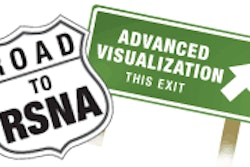SAN FRANCISCO - The routine use of 3D imaging has created a new class of radiologic technologists who specialize in processing and reconstructing 3D imaging studies before the radiologist interprets them. Such individuals can have a beneficial impact on 3D workflow by assuming 3D processing duties once handled by radiologists, according to speakers at the International Symposium on Multidetector-Row CT on Thursday.
The early years of 3D imaging saw many radiologists handling their own 3D image processing and reconstruction. But the practice can become a time sink, with some studies requiring as much as 45 minutes of a radiologist's time for processing.
As a result, radiologists have been stepping back to give RTs a bigger role in data processing, according to Dr. Geoffrey Rubin of Stanford University in California, which sponsored this week's meeting. Stanford established a 3D imaging lab in 1996 that is staffed by technologists and headed by Laura Pierce, an RT. The lab is processing some 650 cases a month, Rubin said.
Having RTs create 3D visualizations fosters an environment in which all 3D reconstructions are created according to the same protocol, Rubin said, which in turn enhances the reliability of results distributed to referring patients and physicians. RTs can also perform a number of specific tasks, including:
- Refining results of automated segmentation to create higher-level segmentation
- Providing quality control, archiving, and communication services
- Creating a single point of 3D image distribution to referring physicians
- Manual creation of curved multiplanar reformations (MPRs), bone removal, standardized views, maximum intensity projections (MIPs), and measurements
In a separate talk, Pierce described the role of a 3D technologist as a mix of craft and science. Moving a technologist into a 3D role can be a major commitment on the part of both the imaging facility and the technologist. The change requires technologists to leave their comfort zone of working with patients, and transition into a job that largely involves sitting in front of computer all day.
What skills make a good 3D technologist? Pierce said that imaging facilities should look for RTs with good computer skills, problem-solving ability, and the ability to navigate within the Windows and Unix operating systems in the event there's a problem with the workstation. Much of this can be learned in basic computer classes, she said.
A background in CT, MRI, vascular, and basic diagnostic imaging is preferred, as it's helpful for the 3D tech to understand how images are acquired and helps their ability to act as a liaison with the CT and MRI departments. An excellent knowledge of anatomy, pathology, and medical terminology can also help as they delve into CT datasets, Pierce said.
Training for a 3D technologist involves the following:
Didactic: Basically, hitting the books. Technologists who specialize in 3D should understand the basics of how a 3D image is created, and principles such as ray casting and voxel projection.
Vendor training: This is vital, but needs to be handled correctly, Pierce said. Facilities should send 3D techs to a basic training session initially, then allow them to return to their departments to apply what they've learned before sending them back to the vendor for training in advanced applications. And technologists shouldn't be trained in 3D visualization at the same time they're learning how to use that new 64-slice CT scanner -- it's just too much data at once.
Clinical fellowships: Stanford is a big believer in clinical fellowships for hands-on training. Techs apply what they've learned in vendor training to real clinical cases. Pierce advised facilities to use cases from their institution rather than those supplied by the vendor, as these more closely represent real-world situations.
Radiology readout conferences: The 3D technologist sits with a radiologist and learns how they read 3D studies. This helps the technologist understand what the radiologist is looking for in 3D reconstructions, Pierce said.
The ongoing shortage of technologists can make it difficult for an imaging facility to move an RT into a role as a dedicated CT tech, especially as multislice technology places additional demands on personnel. But Pierce noted that the number of people who took the RT/CT exam in 2004 increased by 20%, indicating that the shortage could be showing signs of easing.
A 3D technologist training program has been started at Jefferson Community College in Louisville, KY. At present there is no certification required for a 3D technologist as the position does not involve the use of ionizing radiation, Pierce said.
At Stanford, Rubin said that 3D technologists have added an important facet to the university's radiology department.
"I really do believe there is an important role for the 3D lab," Rubin said. "The dedicated technologists that we have there are really superb in a number of things."
By Brian Casey
AuntMinnie.com staff writer
June 17, 2005
Related Reading
Integrated 2D/3D offers workflow, clinical gains, June 17, 2005
3D: Rendering a new era, May 2, 2005
3D and the future of imaging, November 3, 2003
RTs are already tackling advanced tasks, survey says, August 15, 2003
Breast center enlists radiographers for first look at mammograms, March 11, 2003
Copyright © 2005 AuntMinnie.com



















